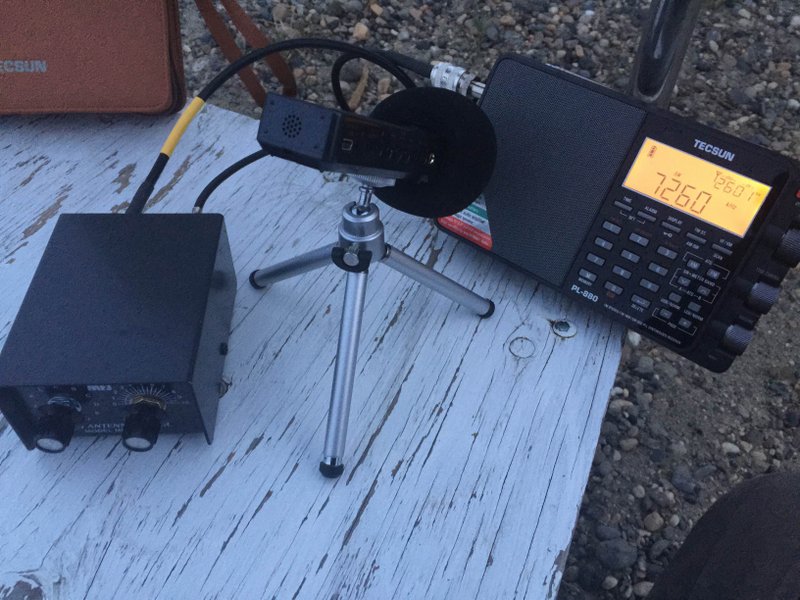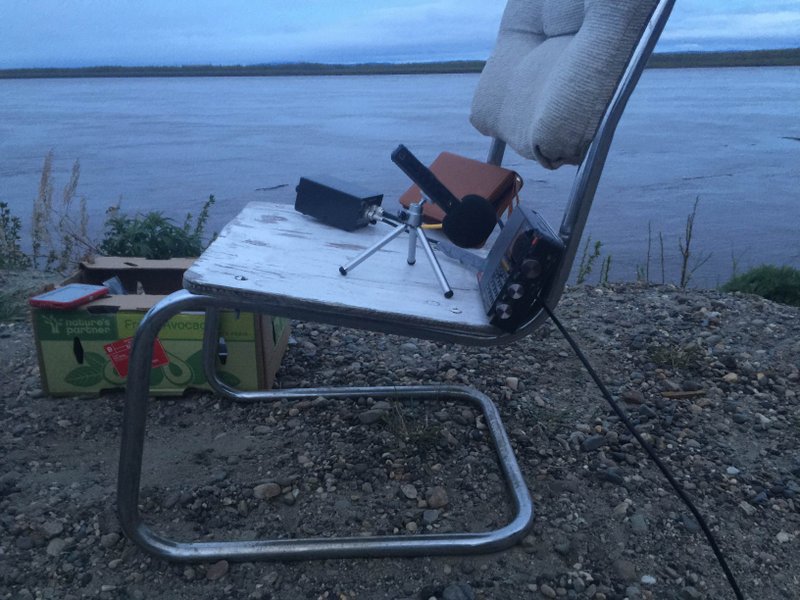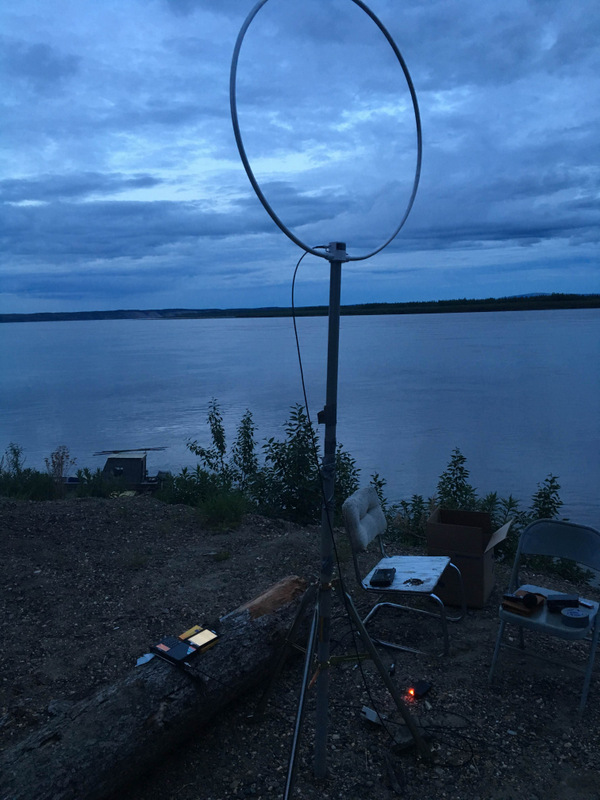I know you can’t cheat physics or RF and that magic pixie dust won’t work, but I’m hoping those with a little more technical expertise can help me solve an antenna dilemma.
I’m in the central interior region of Alaska and want to pick up Radio Vanuatu 7260 kHz a bit better. I also get a somewhat poor signal from them (they may not be running the full 10,000 watts) and I just want something a little better. My problem is that my set up can’t be permanent as I don’t technically have rights to the land I’m on; it’s somewhat public.
I’ve looked at HF beam antennas and some of them can be huge, so that’s likely out of the question. I don’t think a 1/4 wave or 1/2 wave wire dipole would provide drastically better results then a longwire with a tuner, so I don’t want to waste the time and the effort.
I do have a Wellbrook ALA1530LNP and that’s somewhat directional. I also have a 225 foot long wire with an Emtech ZM2 tuner. The Wellbrook and ZM2 do OK.
I do have a Tripod and telescoping mast, so I can handle a beam antenna, it just cant be 30-40 feet! I have no problem carrying a beam antenna and tripod back across the street to my house at the end of a DX session.
Something directional would probably be what’s on order to make this work. I am not going to cheap out on this, but I am certainly not spending $1000 on an antenna….. something in the $200 to $400 range would be fantastic. Returning stuff would be a hassle for me, so I can’t do that.. so I need to buy something that stands a good chance of working.
Am I stuck with my current set up and have no real better options based upon my limitations, is there someway I can make my set up better or is there some kind of antenna that’s directional which I can point right towards Vanuatu which will work that isn’t as big as a house and that doesn’t cost an arm, leg, kidney and foot?
Paul Walker is located in Galena, Alaska and is a regular contributor to the SWLing Post. Be sure to check out Paul’s YouTube channel and SoundCloud channel where everything he logs is recorded and posted. Click here to read his other contributions on the SWLing Post.




I agree with the poster above me about the preamp but I”ve not found an advantage with one so much on one of those supersensetive Tecsuns, some of which seem already electronically jacked up toward overload as it is
I was going to say, I know this is on the simple side but, you mentioned you didn’t think a dipole would work better vs. the longwire/random wire with a tuner, but it can big time esp, if you don’t just so happen to have your longwire resonating at the desired frequency because of its physical length (regardless of the tuner). The tuner doesn’t actually change the properties of the antenna and make it resonate at 7260, it’s just the next best substitute for something that does, working strictly between it and the receiver to do its job. This is great if you’re scanning the dial randomly, but if you had a dipole cut to resonate specifically at 7260 then suddenly the radio station should pop up above all else even better than when you hit the capacitor/coil sweet spot on your current wire.
Resonate dipoles do not a thing for signal to noise ratios.
The advantage of a dipole for 7268 is that it would be pretty small, a little over 64 ft. If you can get it up 40,50,60 ft. it may be worth a try, even if you have to put it up as a sloper. But you may not have trees that tall. And, the answer may be as simple as a RF preamp. With the amp between the tuner and the radio the tuner will act as a tuned circuit and offer some rejection of other signals. If you can’t hear the signal in the first place the preamp is useless but I’ve found that a simple preamp (see link below) that you can build for a few dollars can make the difference on a marginal signal. Be careful not to overload the receiver.
http://www.qsl.net/yo5ofh/hobby%20circuits/rf_circuits.htm
Excellent and Portable ,
LNR Precision EF-SWL Shortwave
http://www.lnrprecision.com/store/#!/EF-SWL-Shortwave/p/39885474
EF-SWL SPECS
DESIGN FREQUENCY 1-30 MHz
TRANSFORMER 9:1 RATIO
GROUNDING USER CONFIGURABLE
RADIATOR LENGTH 45’
RADIATOR MATERIAL 168 STRANDS #36 BLACK POLY COATED FLEX WEAVE
CONNECTOR SILVER/TEFLON SO-239
HARDWARE STAINLESS STEEL
POLARITY USER CONFIGURABLE
About a year ago this site posted that all six Fine Tunings Proceedings books were available on a CD at http://www.odxa.on.ca for $10. I jumped on the offer! These books are an invaluable source of information for SWDXers and contain a number of fantastic articles on antenna design.
I always had great luck putting antennas on natural antenna supports (some people call them trees) using a wrist rocket, a VERY large nail (mine is about 18″ long), a paper plate, fishing line, nylon twine and a brightly colored 0.5 oz fishing weight.
Attach the weight to the fishing line, put the nail through the hole in the spool of fishing line and shove it into the ground on an angle pointing roughly at the top of the tree, through the center of the paper plate, as deeply as possible while still allowing the spool to turn freely. The paper plate keeps the grass from interfering with the line playing out.
Give the line about 20′ of slack (avoid tangles), stand about 2 feet behind the spool and fire away! Find the weight, cut it off, attach the twine to the fishing line, haul it over the tree by rewinding the fishing line, attach the twine to your antenna wire and haul your antenna into the tree and use the twine to secure your antenna to the tree. Repeat as necessary.
I installed a 500′ longwire about 50′ to 70′ above ground every spring upstate New York for many years and it netted Alice Springs _once_ on my Radio Shack DX400.
Do you have a big-ass pine tree there? Run a vertical 35ft insulated wire up that and ground the shielded end to a ground rod at the base of the tree. Being vertical, the lower angle of radiation might make the difference, or it might also increase the noise floor, so you’ll have to experiment. Nice ‘n cheap! Passing thought….
BTW, in summer 1985 I DX’ed over at North Pole, AK with my uncle’s Zenith Trans Oceanic listing to 20M amateur radio QSO’s with just a 15ft longwire. Up there I heard Japan better than I heard Florida.
good thought, about low-angle antenna. Properly made verticals have a preference for low-angle reception and transmission. But would the radio wave be vertically polarized?? Maybe he should tilt the vertical to include some horizontal polarization?? It might also reduce some fading receiving both polarizations.
And a vertical should be half-wavelength long reducing the need for radials.
google “short beverage antenna” and there might be something there. Wire is cheap and if you can modify a beverage antenna to fit the space, and maybe a ultra-low noise preamp, that might do the trick. But even a very low noise amp will just amplify the atmospheric noise. It might be cheaper to call Radio Vanuatu and ask them to steer their antenna more towards Alaska!!!
Just a thought. A good communications radio has a very narrow filter for sideband. If you tune the carrier frequency, then put the radio in upper or lower sideband, your S+N/N signal to noise should improve things.
Most non communication SWL radios sadly are designed for very high microvolt/meter signals. hence many broadcasters use fantastic power, 500 kw and a gain antenna on top of that, giving millions of watts in effective radiated power. Hence and example, I am 8300 miles from southern India, yet in three months have always pulled their 500kw signal in here. It is 15 db over nine here and 30 db over nine in western Europe. I referring to 9.445 Air India’s 3 am IST time transmission for western Europe.
I think TomL’s “short Beverage” idea is something you should try first. Have you tried pointing your longwire precisely at Vanuatu? I would try making it as long as you can, keep it no more than a couple feet off the ground (use bushes or whatever), and just see what happens. Also see what happens when you ground the far end. Good luck!
How much lot space do you have available?
probably 200 ft in length by width by 350 ft in length.. but i can’t/don’t want to take up all of that. I have some shoreline available to me but its very rocky and uneven.
oops, i mean 200 ft in width by 350 ft in length
Any antenna comes with whatever ambient noise may be present. If you front stage of the receiver is not contributing noise, you are good to go. You can’t defeat radio propagation. If the signal fades or more if there is adjacent channel interference from strong signals, it will drive the automatic gain control to attenuate. The desired signal may be lost. I suggest you get a communications radio with a high selectivity and a well designed automatic gain control. Better, shut off the AGC, decrease front end RF gain and your signal will come to you as well as it be possible, given conditions that exist externally.
A communications receiver isn’t very portable, I just sold my JRC NRD535D.
I know I can’t cheat propigationm, but I figure some antenna made for eactly my desired frequency might work better??
Not likely another antenna will help, unless you phase out strong adjacent interference. Receivers are very tolerant of antennas not perfectly impedance matched. Unlike transmitters which are very poor when VSWR is present.
I don’t have any adjacent interference from other stations usually, when trying to listen to Vanuatu.
And I know receivers are tolerant, but the uneducated person in me says an antenna peaked for a certain frequency will do better then one not made for that frequency.
that and a directional antenna will pick up stuff pointed in one direction rather then waste a pick up pattern in areas where the signal isnt coming from?
It cannot improve signal to noise ratio. More gain simply amplifies whatever ambient noise may be present.
If the station is AM, I assume you could cut one of the sidebands , decrease noise and maybe pull it in better. Nose floor will increase as bandwidth.
I should note.. If an antenna made for the 40 meter ham band (7 to 7.3mhz) would work, I’d be interested in that. Similarly, if an antenna tuned for exactly 7260khz is possible, I’m willing to get an antenna for one very specific frequency too.